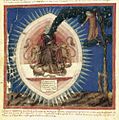Francesco da Barberino

Francesco di Neri di Ranuccio, known better as Francesco da Barberino (1264–1348), was a Tuscan notary, doctor of law and author.
He first went to
He is best known for two didactic works on virtue, the Documenti d'amore for men and the Reggimento e costume di donna for women, written in a mixture of prose and verse in both
Life
Francesco was born into a noble family in
Upon his father's death in 1296, Francesco returned to Barberino.
Francesco lived in
On 28 March 1313, Francesco received a doctorate of both laws by papal bull, although the bishop of Florence would not confirm it for five years.[4] In 1313, he returned to Italy, residing in Venice.[1] His first wife died that year and he married Barna di Tanuccio Rinieri.[5] He returned to Florence in 1314–1315, but soon left again for other cities, including Mantua. He returned definitively to Florence in 1317–1318.[1]
In 1321, Francesco acted as Florentine ambassador to
Francesco died in early April 1348 of the
Works
In Bologna, Francesco first came into contact with the literary circle influenced by
During his transalpine sojourn, he wrote a letter in
Francesco's works were not widely read, but they are now regarded as standing at the head of the Italian etiquette tradition of
Documenti d'amore
The Documenti was probably begun by 1309 and completed by 1315. It is a didactic work aimed at a male bourgeois audience.[2] It is written in Tuscan verse with accompanying Latin translation and explanatory glosses by Francesco. It is an allegorical work, divided into twelve sections of unequal length, each containing the words of a female personification of a virtue, relaying the precepts of chivalry and good behaviour that Love dictated to Eloquence.[2][3] The verse forms vary. Most of the citations of other authors are in the Latin commentary.[3]
The Documenti is a historically valuable text. It contains evidence for dating the composition of the Divine Comedy. It also contains citations of 13th- and 14th-century Occitan, Italian and French poets known from no other source.[2] Francesco was also up to date with the latest literary trends in Italy. Besides Alighieri, Guinizzelli and Cavalcanti, he cites Brunetto Latini, Dino Compagni, Baldo da Passignano and Albertino Mussato.[1][2]
The Documenti is contained in five surviving
-
Triumph of fame from Barb.lat. 4076
-
Triumph of love from Barb.lat. 4076
-
Title page of an edition printed at Rome, 1640
Reggimento e costume di donna
The Reggimento was completed by 1320, slightly later than the Documenti.[2] Francesco claims to be writing at the request of an unnamed lady.[11] It is a courtesy book that complements the Documenti for women.[12] Divided into twenty sections on different virtues, it was intended to be illustrated.[7] It is written entirely in Tuscan, but in a mixture of prose and verse. Certain passages are reminiscent of the cantari.[3] It is of interest as a historical source for the domestic customs and interests of women.[2] It contains the only surviving verses (in translation) of the trobairitz Lisa de Londres.[13]
The Reggimento is known from two copies in a single manuscript tradition, both now in the Vatican: Barb.lat. 4001 and its copy, Capponiano 50.[14]
Notes
- ^ a b c d e f g h i j k l m n o p q r Pasquini 1997.
- ^ a b c d e f g h i j k l m n o p q Allaire 2004.
- ^ a b c d e Davie 2002.
- ^ Pasquini 1997 writes that the bishop received the bull on 8 August 1313, but delayed the granting of the degree. Allaire 2004 says that the degree was granted at Florence in 1315.
- ^ Pasquini 1997 gives the date as 1313, but Allaire 2004 says only "c. 1314".
- ^ Stoppino 2009, p. 127.
- ^ a b Stoppino 2009, p. 128.
- ^ a b Stoppino 2009, p. 129.
- ^ Bischetti 2021, p. 13. There are online colour digitizations of both manuscripts: 4076 and 4077.
- ^ Bischetti 2021, p. 13.
- ^ According to Stoppino 2009, p. 128, "the Reggimento is presented as a book written to fulfil the request of a mysterious and unnamed lady, who asks Francesco to prepare a conduct manual for women to be added to the many existing for men." Allaire 2004 says that it is dedicated to Mary, mother of Jesus.
- ^ Allaire 2004 and Davie 2002 both describe the prose as "rhythmic".
- ^ Paden 2018, p. 118.
- ^ Stoppino 2009, p. 129. There are online colour digitizations of both manuscripts: 4001 and Capponiano 50.
Bibliography
- Allaire, Gloria (2004). "Francesco da Barberino". In Christopher Kleinhenz (ed.). Medieval Italy: An Encyclopedia. Vol. 2. Routledge. pp. 364–365.
- Bischetti, Sara (2021). "Il punto sui manoscritti dei Documenti d'Amore". In Sara Bischetti; Antonio Montefusco (eds.). Francesco da Barberino al crocevia: Culture, società, bilinguismo. De Gruyter. pp. 13–36.
- Davie, Mark (2002). "Francesco Da Barberino". In Peter Hainsworth; David Robey (eds.). The Oxford Companion to Italian Literature. Oxford University Press.
- Paden, William D. (2018). "The Lives of the Troubadours: A New Biographical Dictionary". Romance Philology. 72 (1): 111–124.
- Pasquini, Emilio (1997). "Francesco da Barberino". ISBN 978-8-81200032-6.
- Stoppino, Eleonora (2009). "The Italian Reggimento e costumi di donna (selections) and Documenti d'amore (selections) of Francesco da Barberino". In Mark Johnston (ed.). Medieval Conduct Literature: An Anthology of Vernacular Guides to Behaviour for Youths with English Translations. University of Toronto Press. pp. 127–183. .
External links
 Works related to Francesco da Barberino at Wikisource
Works related to Francesco da Barberino at Wikisource Quotations related to Francesco da Barberino at Wikiquote
Quotations related to Francesco da Barberino at Wikiquote



